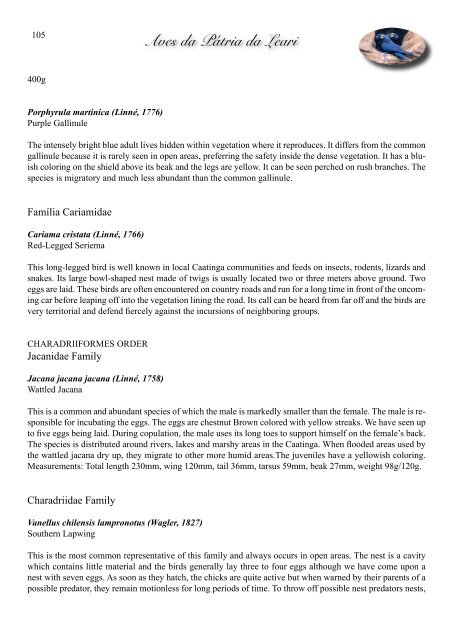Aves da Pátria da Leari - Sociedade Brasileira de Ornitologia
Aves da Pátria da Leari - Sociedade Brasileira de Ornitologia
Aves da Pátria da Leari - Sociedade Brasileira de Ornitologia
Create successful ePaper yourself
Turn your PDF publications into a flip-book with our unique Google optimized e-Paper software.
105<br />
400g<br />
Porphyrula martinica (Linné, 1776)<br />
Purple Gallinule<br />
<strong>Aves</strong> <strong>da</strong> <strong>Pátria</strong> <strong>da</strong> <strong>Leari</strong><br />
The intensely bright blue adult lives hid<strong>de</strong>n within vegetation where it reproduces. It differs from the common<br />
gallinule because it is rarely seen in open areas, preferring the safety insi<strong>de</strong> the <strong>de</strong>nse vegetation. It has a bluish<br />
coloring on the shield above its beak and the legs are yellow. It can be seen perched on rush branches. The<br />
species is migratory and much less abun<strong>da</strong>nt than the common gallinule.<br />
Família Cariami<strong>da</strong>e<br />
Cariama cristata (Linné, 1766)<br />
Red-Legged Seriema<br />
This long-legged bird is well known in local Caatinga communities and feeds on insects, ro<strong>de</strong>nts, lizards and<br />
snakes. Its large bowl-shaped nest ma<strong>de</strong> of twigs is usually located two or three meters above ground. Two<br />
eggs are laid. These birds are often encountered on country roads and run for a long time in front of the oncoming<br />
car before leaping off into the vegetation lining the road. Its call can be heard from far off and the birds are<br />
very territorial and <strong>de</strong>fend fiercely against the incursions of neighboring groups.<br />
CHARADRIIFORMES ORDER<br />
Jacani<strong>da</strong>e Family<br />
Jacana jacana jacana (Linné, 1758)<br />
Wattled Jacana<br />
This is a common and abun<strong>da</strong>nt species of which the male is markedly smaller than the female. The male is responsible<br />
for incubating the eggs. The eggs are chestnut Brown colored with yellow streaks. We have seen up<br />
to five eggs being laid. During copulation, the male uses its long toes to support himself on the female’s back.<br />
The species is distributed around rivers, lakes and marshy areas in the Caatinga. When floo<strong>de</strong>d areas used by<br />
the wattled jacana dry up, they migrate to other more humid areas.The juveniles have a yellowish coloring.<br />
Measurements: Total length 230mm, wing 120mm, tail 36mm, tarsus 59mm, beak 27mm, weight 98g/120g.<br />
Charadrii<strong>da</strong>e Family<br />
Vanellus chilensis lampronotus (Wagler, 1827)<br />
Southern Lapwing<br />
This is the most common representative of this family and always occurs in open areas. The nest is a cavity<br />
which contains little material and the birds generally lay three to four eggs although we have come upon a<br />
nest with seven eggs. As soon as they hatch, the chicks are quite active but when warned by their parents of a<br />
possible pre<strong>da</strong>tor, they remain motionless for long periods of time. To throw off possible nest pre<strong>da</strong>tors nests,

















